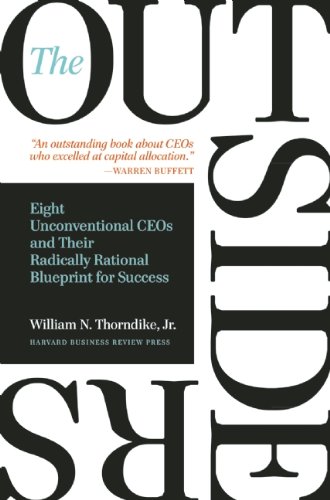

This article is an excerpt from the Shortform summary of "The Outsiders" by William N. Thorndike, Jr. Shortform has the world's best summaries of books you should be reading.
Like this article? Sign up for a free trial here .
What makes a newspaper successful? How does the Washington Post’s history prove that a publication can succeed both as a business, and for its journalistic merit?
The Washington Post’s history was mostly spent as a local newspaper, and Graham sought a way to grow the company, while increasing its journalistic prestige. During her time as CEO, Graham was able to do both, by focusing on the business and hiring the best people to get the job done.
Washington Post: History and Katharine Graham as CEO
The Washington Post’s history was forever altered when Katharine Graham took over. Previously, the Post was owned by Eugene Meyer, whose daughter was Katharine Graham. Her husband, Philip Graham, was hired by Meyer to lead the Washington Post from 1946 to 1963. However, Philip committed suicide in 1963, and Katharine was expected to take over management.
An inexperienced executive, Katharine hadn’t worked for 20 years when she took the CEO role. But through wise decisions around both editorial and business, the help of strong executives, and a key advisor by the name of Warren Buffett, she led the Post to be the most successful newspaper company of its class, and Katharine herself became the most famous CEO in Washington Post history.
Washington Post History After 1963
In 1963, Katharine Graham became CEO of the Washington Post. At the time, the Post had grown to include Newsweek magazine and three TV stations. She spent a few years learning the ropes.
In 1967, she made an unconventional staffing choice—she replaced her veteran editor-in-chief with a young firebrand, Ben Bradlee. Changing from a veteran to a newcomer was an odd choice, and certainly unheard of this far in Washington Post history, but Graham believed she needed someone with a better grasp of the 1960s zeitgeist. Bradlee’s energy would prove vital in raising the profile of the Post’s newsroom in its stories.
In 1971 and 1972, the Post clashed with the Nixon administration over stories critical of the presidency. This included the breakthrough investigation of the Watergate scandal. Despite the Nixon administration’s threats to impede the Post with regulatory scrutiny, Graham pushed forward and published the stories. These elevated the stature of the Washington Post, putting it on equal footing with the New York Times. It is considered a major turning point in Washington Post history.
In 1971, Graham took the Washington Post Company public to raise money for acquisitions. She started by buying the Trenton Times, which was a #2 paper in a competitive market and showed mediocre performance. This would teach her discipline in acquisitions going forward.
In 1974, a relative unknown began buying stock in the Post, ending with 13% ownership. His name was Warren Buffett. While her board counseled her to avoid the unknown, she met with him and found his advice indispensable, and she invited him to join the board. He would prove to be vital throughout Graham’s tenure, advising her around capital allocations, a part of the Washington Post’s history that would prove lucrative.
In 1975, the Post faced a worker’s strike from the paper printers. Determined not to give in, Graham hastily hired a crew to man newspapers, publishing for 139 days before the printers conceded. Winning many favorable concessions, Graham made big improvements to the Post’s margins.
Around this time, Buffett advised Graham to repurchase Post shares, given their low prices. She repurchased 40% of Post shares, an unusual move that her competitors didn’t follow.
In 1981, the other major newspaper in Washington, the Washington Star, shut down. The Post became a monopoly daily newspaper in Washington, D.C., which greatly increased its circulation and profitability.
Also in 1981, Graham hired a strong COO, Dick Simmons. Like other COOs for the outsider CEOs in this book, Simmons carried operational excellence to the Post’s business units, increasing margins improving compensation structure.
During the 1980s, the newspaper industry went on an acquisition spree, bidding up prices aggressively. Graham didn’t participate, finding the assets overpriced. Instead, they looked to businesses outside media, acquiring companies in telephone, test preparation (Kaplan), and cable television (from Capital Cities). Each of these would both rise in value and provide a valuable counterweight to the newspaper business as it declined due to the Internet.
As the early 1990s approached with a recession, the Post became acquisitive while its competitors sat back, over-saddled with debt. Graham purchased companies at significant discounts in cable television, TV, and education. The Washington Post’s history of caution and conservative acquisition strategy in the past helped improve its standing and value.
Graham stepped down in 1993, leaving a legacy of strong performance and excellent financial returns.
Performance
From 1971 to 1993, the Washington Post Company showed a 22.3% annual return rate, compared to 7.4% for the S&P 500 and 12.4% for public newspapers.
$1 invested at the beginning would have been worth $89 by the end. This outperformed the S&P by 18 times, and her peers by six times.
The Washington Post’s history shows that even inexperienced people can run successful companies, if they think outside the box, and work to find solutions that benefit their business. Katharine Graham was one of the top CEOs in Washington Post history, and her contributions raised the status of the company.

———End of Preview———
Like what you just read? Read the rest of the world's best summary of William N. Thorndike, Jr's "The Outsiders" at Shortform .
Here's what you'll find in our full The Outsiders summary :
- What great CEOs like Warren Buffett do that average CEOs don't
- How to master the art of capital allocation
- How to be a great manager that your team is excited to work with






